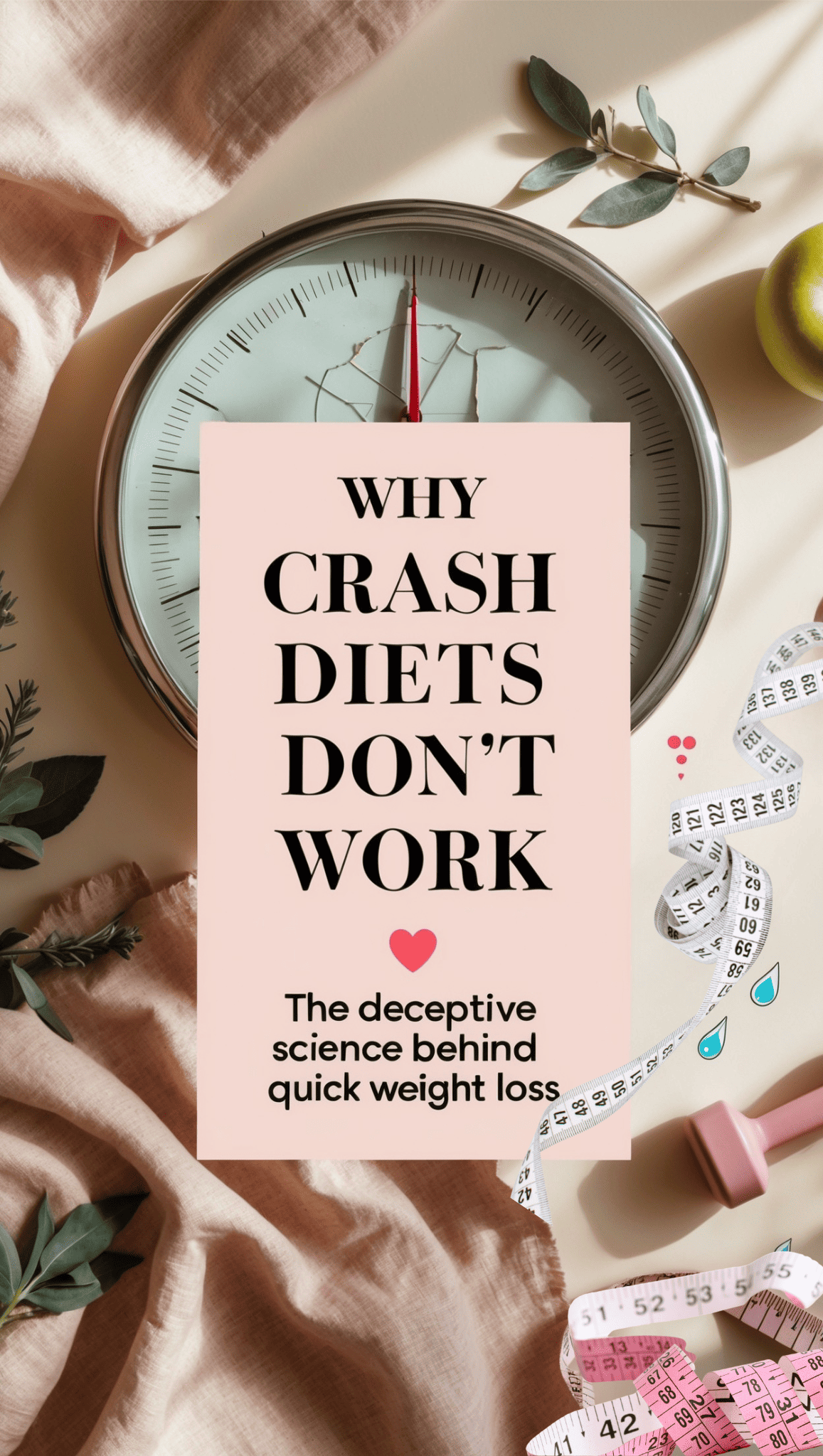
Table of Contents
Have you ever been tempted by those “lose 10 pounds in a week” promises? You’re definitely not alone! Crash diets have become increasingly popular in our instant-gratification society, promising dramatic results with minimal effort. But beneath their appealing exterior lies a complex web of deception that leaves millions frustrated, discouraged, and often heavier than when they started!
The allure of quick fixes is undeniably strong in our fast-paced world. We scroll through social media, bombarded by before-and-after photos showcasing seemingly miraculous transformations, all while celebrities endorse the latest fad diet claiming to be their secret weapon.
Unfortunately, these dramatic weight loss approaches ignore the fundamental science of how our bodies actually work, setting us up for a cycle of initial success followed by inevitable failure. Let’s uncover why these quick-fix diets don’t deliver on their long-term promises!
This post may contain affiliate links. I only recommend products and services I genuinely believe in. Additionally, some images on this website may have been created with the help of AI to convey the feeling I wish to share with the reader.
What You Might Need
- Food journal to track eating patterns and emotional triggers
- Body composition measurement tools (scale with body fat percentage, measuring tape)
- Access to a healthcare provider for personalized advice
- Sustainable meal plan focused on whole foods
- Support system for encouragement during lifestyle changes
1. The Deceptive Appeal of Crash Diets: Why They Draw Us In

Ever wondered why crash diets continue to thrive despite their notorious failure rates? I have! Several years ago, I found myself reaching for a “detox tea” program that promised to help me drop 15 pounds before a friend’s wedding.
The magnetic pull of that quick-fix solution was overwhelming when I felt desperate for change. That immediate promise of transformation spoke directly to my insecurities, offering what seemed like the perfect shortcut to confidence in that bridesmaid dress.
When celebrities share their dramatic “detox” results or influencers promote their 3-day juice cleanses with stunning before-and-after photos, it creates a powerful illusion of accessibility. We think, “If it worked for them, surely it will work for me too!” This visual proof, combined with convincing testimonials and pseudo-scientific claims, forms a perfect storm of persuasion that’s difficult to resist.
Trust me. The statistics don’t lie—over 45% of Americans attempt some form of crash diet annually, yet long-term success rates remain dismally low. Isn’t it strange how we keep trying approaches with such poor track records?
The Irresistible Promise of Rapid Results
The human brain is wired to seek immediate rewards. Crash diets capitalize on this by promising dramatic weight loss in mere days. Your brain’s reward center lights up at these promises! This neurological reaction can override logical thinking about sustainability.
How Media and Celebrity Culture Fuel Diet Trends
Social media platforms and celebrity endorsements normalize extreme approaches to weight loss, making dangerous restrictions seem glamorous and effective. We rarely see the behind-the-scenes reality: the extreme hunger, low energy, and professional support teams making these “simple” diets possible.
The Psychology of Quick-Fix Solutions
Our tendency to seek shortcuts stems from our discomfort with the reality that sustainable change requires consistent effort over time. It’s not your fault! We’re bombarded with messages suggesting transformation should be fast and easy.
Steps to Recognize Deceptive Diet Marketing
- Look for unrealistic claims of rapid weight loss (more than 1-2 pounds weekly)
- Be skeptical of before/after photos, especially when taken days apart
- Question diets that eliminate entire food groups without medical necessity
- Watch for emotional manipulation techniques that prey on insecurities
- Research the science behind claims rather than relying on testimonials
Picture This
You’re standing in the grocery checkout line, surrounded by magazine covers showcasing “miracle” diets promising transformation in just days. Your stomach tightens. Your hand reaches for the magazine. The emotional pull is powerful—imagining yourself achieving those same results so quickly. But beneath that glossy exterior lies the uncomfortable truth about crash diets: they’re selling an illusion that your body’s biology simply won’t support long-term.
2. The Psychology Behind Our Quick-Fix Mentality

I’ve always been fascinated by how our minds can override our better judgment when it comes to weight loss! At one point in my fitness journey, I caught myself nearly buying an expensive “7-day metabolism reset” program despite knowing better.
Why? The psychology behind our attraction to crash diets runs deeper than simple impatience—it’s woven into the fabric of our modern culture. We live in a world of Amazon same-day delivery, streaming on demand, and instant communication. Of course we expect immediate results from our bodies too!
This instant gratification mindset creates the perfect foundation for marketers to exploit our vulnerabilities. Diet companies understand that by promising quick results, they’re tapping into powerful psychological triggers. They craft messaging that speaks directly to our emotional pain points. “Summer body in 14 days!” “Drop a dress size by Friday!”
These phrases create a sense of urgency and desperation that can lead us down increasingly extreme paths. I’ve been there. You’ve probably been there too. And it’s not because we’re weak—it’s because we’re human.
The Instant Gratification Culture We Live In
Our society has evolved to expect immediate results in all aspects of life, creating unrealistic expectations about body changes. Think about it: when was the last time you were willing to wait for anything? We’ve lost our patience muscle, and it shows in how we approach weight loss.
Marketing Tactics That Exploit Our Vulnerabilities
Diet industry marketing capitalizes on insecurities by promising quick fixes, using carefully crafted psychological triggers. Notice how ads often feature people looking sad before their transformation? That’s deliberate emotional manipulation designed to make you feel inadequate and desperate for their solution.
The Dangerous Cycle of Diet Desperation
Each failed diet attempt can lead to more extreme measures, creating a destructive pattern of restriction and rebound. After each crash diet failure, you don’t just return to your starting point—you often end up more desperate and willing to try something even more extreme. Break this cycle!
Steps to Develop a Healthier Mindset About Weight Management
- Practice recognizing and questioning thoughts that demand immediate results
- Set process-based goals (like eating more vegetables) rather than outcome-based goals
- Build awareness of emotional triggers that lead to seeking quick fixes
- Surround yourself with voices that promote sustainable approaches to health
- Focus on non-scale victories like energy levels, sleep quality, and mood improvements
Picture This
You’re feeling frustrated after weeks of sensible eating without dramatic scale changes, when an ad for a crash diet pops up promising immediate results. Your heart beats faster. For a moment, that old familiar excitement rises—the possibility of finally finding the “secret” to rapid weight loss. But then you pause, take a deep breath, and recognize this thinking pattern for what it is: the quick-fix mentality that has sabotaged your efforts so many times before.
3. The Water Weight Deception: Understanding What You’re Really Losing

When I first learned about the science of initial weight loss, it completely changed my perspective on crash diets! A client of mine shared with me that she once lost an “impressive” 11 pounds in her first week of a low-carb diet.. she was ecstatic—until I explained to her what was really happening. Those dramatic first-week results that keep us coming back to extreme diets aren’t actually the fat loss we’re hoping for—they’re primarily water weight and glycogen (stored carbohydrates).
Our bodies store glycogen alongside water in a ratio of about 1:3, meaning for every gram of glycogen we lose, we also lose about three grams of water. That’s not fat loss—that’s just depleting your body’s energy reserves and their associated water!
This biological reality creates a perfect storm of false hope when we start a crash diet. That immediate drop on the scale feels incredibly rewarding and validating. The numbers don’t lie, right? Wrong! As soon as you reintroduced carbs, upwards of seven pounds can return with in days. It wasn’t fat returning—it is simply your body restoring its normal water and energy balance.
The Science of First-Week Weight Loss
Initial rapid weight loss during crash diets comes primarily from water and glycogen depletion, not actual fat loss. Your body can only metabolize a limited amount of fat per day—regardless of how little you eat! The rest of that impressive initial “loss” is simply water, which will return.
Why Quick Results Create False Confidence
Early weight loss success can reinforce belief in unhealthy dieting approaches despite being physiologically temporary. It’s a cruel trick! You feel successful and motivated, but you’re celebrating something that isn’t sustainable or even meaningful for long-term health.
The Timeline of True Fat Loss vs. Water Weight
Sustainable fat loss occurs at a rate of 1-2 pounds weekly, while water weight can fluctuate by 5+ pounds daily. Did you drink a salty soup last night? Expect to be “up” 2-3 pounds from water retention. Had an intense workout? You might be “down” 2 pounds from sweat loss. Neither reflects actual body composition changes!
Steps to Identify True Progress Beyond Water Weight
- Track measurements rather than relying solely on scale weight
- Look for changes in how clothes fit rather than daily scale fluctuations
- Pay attention to energy levels and physical performance improvements
- Consider taking progress photos monthly rather than weighing daily
- Understand that sustainable fat loss takes time—typically 4-8 weeks to see significant changes
Picture This
You’re one week into a new diet, thrilled by the quick eight-pound drop on your scale. Your jeans feel slightly looser. There’s a powerful feeling of accomplishment and motivation fueling your restriction. What you don’t realize is that your body is simply depleting its glycogen reserves and releasing associated water—not primarily burning fat. When you eventually return to normal eating, those pounds will return swiftly, creating the confusion and frustration that perpetuates the crash diet cycle.
4. Beyond the Scale: Why Body Composition Matters More Than Weight

I spent years obsessing over that number on the scale before realizing it was telling me so little about my actual health! At my “heaviest” weight, I was actually my healthiest—with more muscle, better energy, and improved lab results than when I was “skinnier” but undernourished. Body composition—the ratio of fat to lean mass in your body—offers a much more meaningful picture of physical health than weight alone.
Two people can weigh exactly the same but have dramatically different body compositions, resulting in different appearances, health markers, and metabolic rates. I’ve seen this firsthand with clients who wore the same size but looked completely different based on their muscle-to-fat ratio.
Understanding this concept completely transforms how we should approach weight management. When we pursue crash diets that create rapid weight loss, we’re often losing precious muscle along with fat and water.
This actually damages our metabolism long-term. Focusing exclusively on the scale can lead us down a destructive path, while measuring actual body composition gives us valuable feedback about our health journey.
The Difference Between Weight Loss and Fat Loss
Weight includes everything from muscle and bone to water and digestive contents, while fat loss specifically targets adipose tissue. The scale can’t tell you which is which! That’s why the number can be so misleading and emotionally destructive when used as your only measurement tool.
Tools That Measure What Really Matters
Modern technology offers accessible ways to track body composition beyond the misleading bathroom scale. From simple measuring tapes to bioelectrical impedance scales to DEXA scans, we now have multiple options for understanding what’s actually happening with our bodies.
Why Muscle Preservation Is Critical for Metabolism
Maintaining lean mass during weight loss helps preserve metabolic rate and prevents the rebound effect common after crash diets. Each pound of muscle burns approximately 6 calories per day at rest, while fat burns only 2-3. More muscle means a higher metabolism!
Steps to Track Body Composition Changes Effectively
- Consider investing in a bioelectrical impedance scale for at-home body fat percentage estimates
- Take monthly measurements of waist, hips, arms, and thighs to track changes
- Pay attention to how clothes fit as a practical indicator of body composition changes
- Try progress photos in similar lighting/clothing every 4-6 weeks
- Focus on performance metrics like strength, endurance, and energy levels
Picture This
You step on the scale after weeks of sustainable lifestyle changes to find your weight hasn’t changed dramatically. Your heart sinks. Momentary disappointment washes over you. But then you notice your clothes fitting differently, your energy levels soaring, and your body measurements showing significant changes. You feel stronger. You sleep better. This is the reality of true body composition improvement: sometimes invisible on the scale but transformative for your health, metabolism, and long-term weight management success.
Want to Break Free from the Crash Diet Cycle?
As you’ve learned throughout this article, crash diets don’t work long-term, but understanding the science behind sustainable weight loss is just one piece of a successful transformation. Creating lasting results requires a personalized approach that integrates proper nutrition, psychological strategies, body composition monitoring, and consistency—all tailored to your unique body and metabolism.

Ready for a Customized Approach to Your Wellness Journey?
My Sustainable Wellness Foundation Audit helps you cut through the diet industry noise and create a comprehensive strategy that works specifically for you. During this 90-minute audit session, we’ll assess your current habits, identify your diet cycle patterns, and develop a practical plan focused on gradual, sustainable changes rather than quick fixes.
You’ll receive a personalized blueprint that addresses not just nutrition but all the critical elements that support your success—from body composition tracking to psychological tools that break the quick-fix mentality. Skip the frustrating cycle of crash diets and rebound weight gain, and start your journey with clarity and confidence. Book your Sustainable Wellness Foundation Audit today and transform your approach to lasting success!
Personalized Wellness Plan Development

Final Thoughts
Understanding why crash diets fail isn’t just about avoiding a common mistake—it’s about fundamentally shifting how we approach our health and bodies. The science is clear: our bodies are sophisticated biological systems that resist drastic changes and fight to maintain homeostasis.
Quick fixes might provide temporary results, but they inevitably lead to frustration, metabolic damage, and often more weight gain in the long run.
Instead of chasing the next miracle diet, consider embracing a more compassionate and scientifically-sound approach to weight management. This means accepting that meaningful, lasting changes happen gradually through sustainable lifestyle modifications that you can maintain for life. It means shifting focus from the scale to how you feel, how you perform, and the quality of your daily habits.
Remember that your worth is never determined by a number on a scale or how quickly you can lose weight! The diet industry thrives on our insecurities and impatience, but true health is built through consistent, reasonable choices that honor your body’s complex needs and biological realities. By understanding the science behind why crash diets don’t work, you’re already one step ahead in building a healthier relationship with food and your body.
The next time you’re tempted by promises of dramatic, quick results, pause and ask yourself: “Is this approach sustainable for life?” If the answer is no, it’s probably not worth pursuing. Your body deserves better than the cycle of restriction, rebound, and guilt that crash diets inevitably create!
If you’re ready to embrace lasting, sustainable changes, we’ll create a clear roadmap tailored to achieve your desired results. Shift away from diet culture and begin your journey toward a fulfilling wellness lifestyle.

This post may contain affiliate links. I only recommend products and services I genuinely believe in. Additionally, some images on this website may have been created with the help of AI to convey the feeling I wish to share with the reader.
Frequently Asked Questions
How much weight loss per week is considered healthy and sustainable?
Healthy, sustainable weight loss typically ranges from 0.5-2 pounds per week for most individuals. This rate allows your body to primarily lose fat while preserving valuable muscle mass and metabolic function. Remember that even this modest weekly loss adds up to significant changes over time—potentially 25-100 pounds in a year if consistently maintained. Anything promising substantially faster results will likely involve water weight loss and muscle breakdown rather than sustainable fat loss.
Will I ever lose the weight as quickly as I did on my first crash diet?
That dramatic initial weight loss you experienced was primarily water weight and glycogen depletion, not actual fat loss. Your body can only metabolize fat at a certain rate (generally 1-2 pounds weekly maximum), regardless of how severely you restrict calories. While you might see quick water weight changes with any dietary shift, sustainable fat loss follows a much slower timeline. Focus on creating sustainable habits that support gradual, permanent changes rather than chasing those misleading early results.
How can I break the cycle of crash dieting for good?
Breaking free from the crash diet cycle starts with addressing the psychological patterns that drive it. Begin by practicing mindful eating—paying attention to hunger/fullness cues and emotional triggers. Work on developing a flexible approach to nutrition that eliminates “forbidden foods” while emphasizing nutrient-dense choices most of the time. Consider working with a registered dietitian who specializes in intuitive eating or sustainable weight management. Remember that consistency with moderate approaches always outperforms perfection with extreme measures when it comes to long-term success.
How do I know if my diet approach is sustainable?
A sustainable approach to nutrition should pass several key tests. First, ask yourself if you could realistically eat this way for the next year—not just the next few weeks. Consider whether the approach allows for social occasions, travel, and real-life flexibility. Evaluate whether it provides adequate nutrients and energy for your daily activities without causing persistent hunger, fatigue, or preoccupation with food. Finally, notice if it supports other aspects of health like good sleep, stable mood, and consistent energy levels. If it fails these tests, it’s likely not sustainable regardless of short-term results.
What role does exercise play in sustainable weight management?
Exercise is crucial for sustainable weight management, but not primarily because of the calories it burns. Regular physical activity helps preserve muscle mass during weight loss, improves insulin sensitivity, reduces stress that can drive emotional eating, and raises your metabolic rate. For optimal results, combine regular strength training (to maintain muscle) with cardiovascular activity (for heart health and calorie expenditure) and daily movement (like walking). The best exercise plan is one you enjoy enough to maintain consistently, rather than extreme approaches you’ll quickly abandon.
About The Author
Jahlila is a Transformational Whole Self and Wellness Lifestyle Empowerment Coach, a devoted mother, passionate writer, and a fervent advocate for holistic wellness. She is the creator of The Tri-Sync Method, a comprehensive coaching program designed to help women establish a personalized wellness and self-care lifestyle for enduring total health wellness.
Her journey has transitioned from focusing solely on health and fitness to embracing a broader mission: empowering women through holistic approaches that unite body, mind, and spirit. Jahlila is dedicated to teaching, coaching, writing, and speaking about how wellness intersects with a joyful, balanced life. Her mission is to motivate women to prioritize and achieve their wellness goals, fostering a deep connection between a vibrant lifestyle and true happiness. Ready to reclaim your vitality, achieve mental clarity, and embrace your wellness journey? Explore more at The Tri-Sync Method.Com
Don’t wait another day to start living your healthiest, happiest life. Schedule a Free Discovery Consultation with Jahlila today to explore how The Tri-Sync Method can transform your life. For additional questions or personalized guidance, please visit our Contact Page.




Leave a Reply